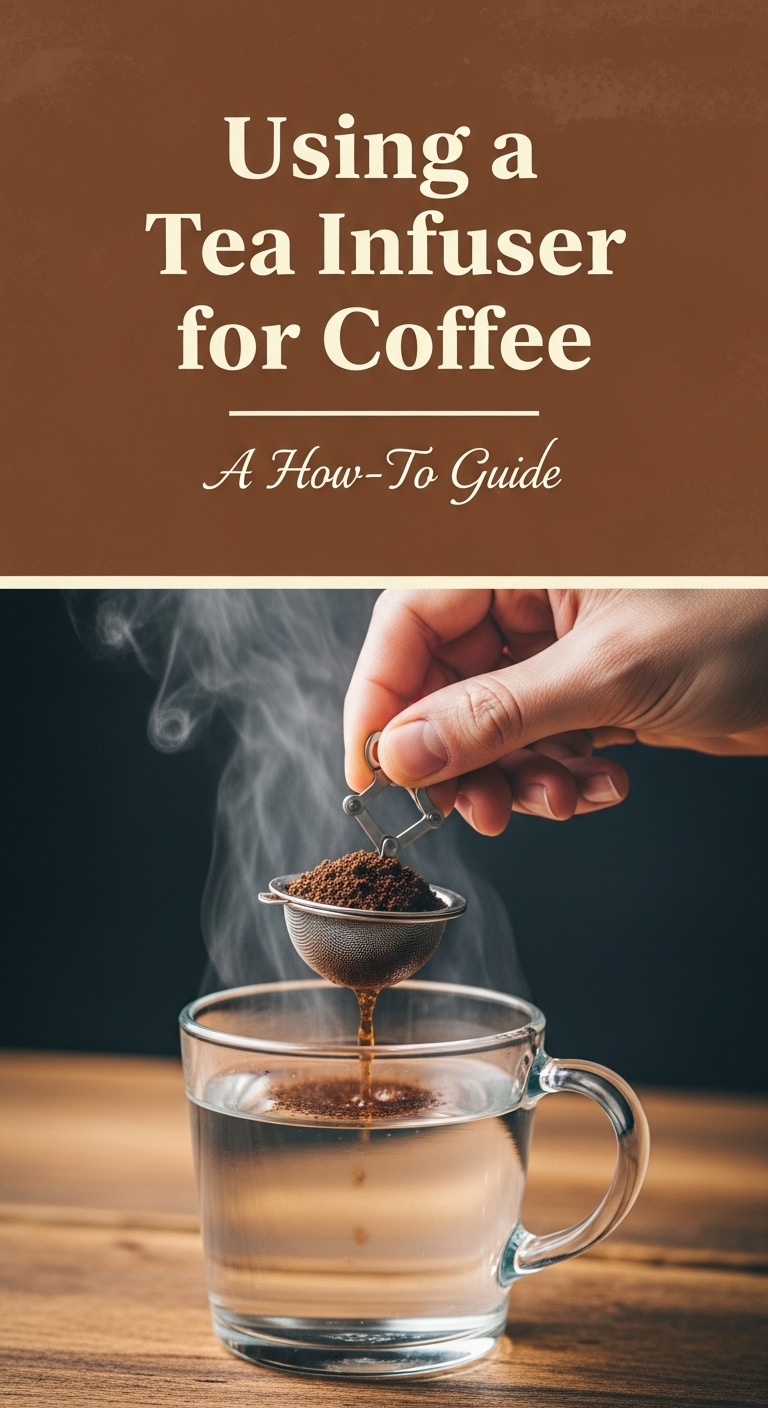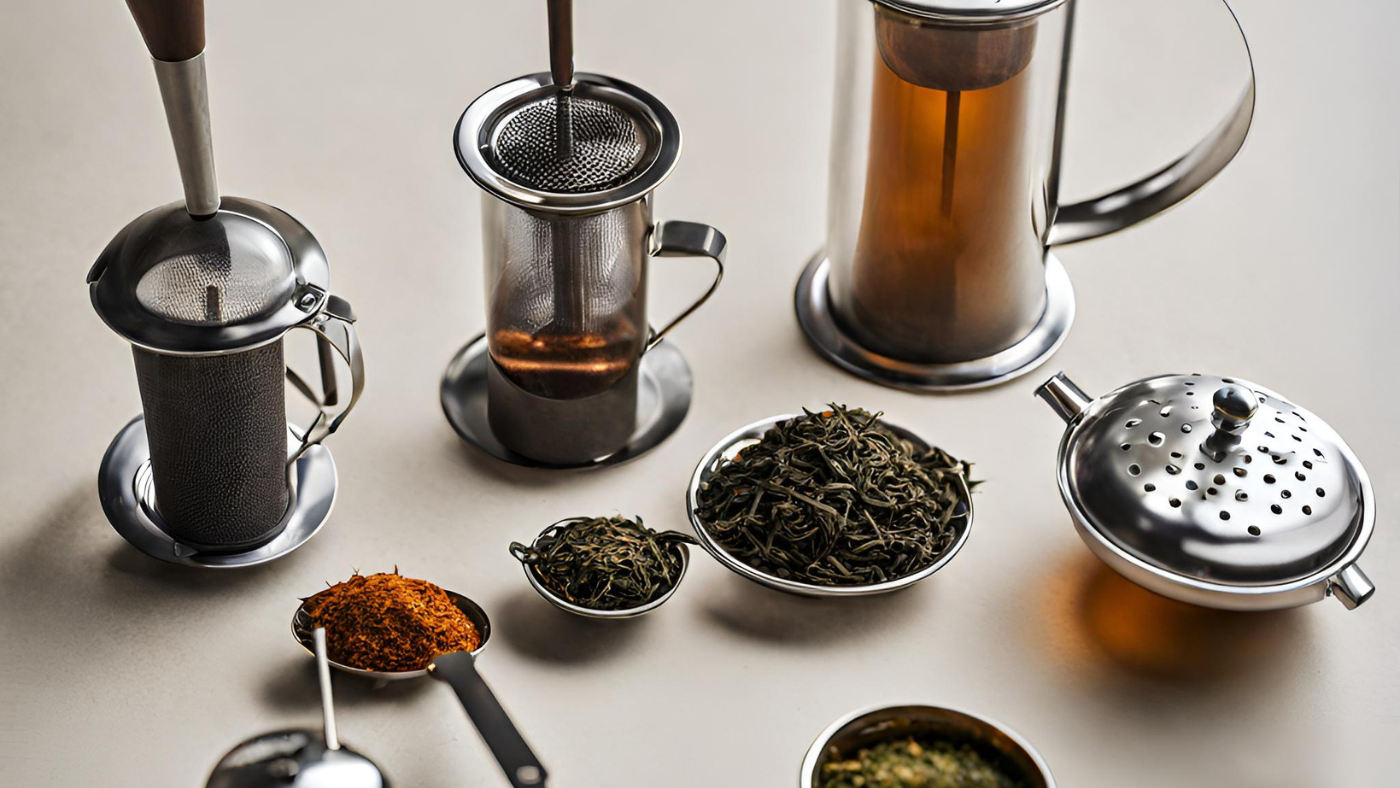As an Amazon Associate CoffeeXplore.com earns from qualifying purchases.
Using a Tea Infuser for Coffee: A How-To Guide
Ever found yourself without a coffee maker but craving a fresh cup? You glance at your tea drawer and wonder: can a tea infuser be used for coffee? Many people face this exact situation, looking for a simple, quick, and affordable way to brew a single serving without specialized equipment.
Yes, a tea infuser can be used to brew coffee. It is a viable, convenient, and affordable method, especially for single servings, that produces a flavor profile similar to a French press. This method allows you to steep coffee grounds directly in your mug, offering a surprisingly rich and full-bodied taste.
Leveraging extensive analysis of established brewing patterns and data, this guide unpacks the proven step-by-step process and critical insights to help you effectively use a tea infuser for coffee. We’ll cover everything from choosing the right infuser and grind size to mastering both hot and cold brew techniques, ensuring you get a perfect cup every single time.
Key Facts
- A Proven Method: Using a tea infuser is a practical and affordable alternative to traditional coffee makers, especially for single servings and on-the-go brewing.
- Grind Size is Critical: A medium-coarse grind is essential for success. Data shows a fine grind leads to over-extraction, creating a bitter, dry, and hollow flavor while also leaking sediment through the mesh.
- Optimal Hot Brew Time: For hot coffee, the ideal steeping time is 3-4 minutes, a duration very similar to that of a French press, which helps achieve a balanced and rich flavor.
- Excellent for Cold Brew: Tea infusers are highly effective for making cold brew. The recommended process involves steeping coarsely ground coffee for 12 to 24 hours in the refrigerator.
- Unique Flavor Profile: This method produces a full-bodied coffee, retaining more natural oils than pour-over methods because no paper filter is used. The taste is often described as rich but more delicate than a French press.
Yes, You Can Use a Tea Infuser for Coffee: Here’s How
Yes, a tea infuser can be used to brew coffee. It is a viable, convenient, and affordable method, especially for single servings, that produces a flavor profile similar to a French press.
Ever found yourself without a coffee maker but craving a fresh cup? Your tea infuser might just be the hero you need. This technique for making coffee with a tea infuser isn’t just a desperate measure; it’s a known, practical method that leverages a tool many people already own. Its convenience and affordability make it a fantastic alternative, allowing you to steep coffee like tea for a quick and satisfying brew without the fuss of a large machine.
The 2 Critical Factors: Choosing the Right Infuser & Grind
For best results, use a tea infuser with a fine mesh to prevent sediment and medium-coarse ground coffee to avoid a bitter, over-extracted taste.

Before you even think about heating water, getting these two elements right is the key to success. The type of infuser and the size of your coffee grounds will make or break your final cup. Failing to choose correctly can lead to a muddy, bitter brew, but with the right tools, you can produce a cup that rivals more traditional methods.
Pro Tip: Think of the infuser’s mesh like a security guard for your coffee. You want one that’s strict enough to keep the grounds out, but lets all the flavor through!
Here’s what you need to look for:
- Fine Mesh: The most important feature of a tea infuser for coffee is an ultra-fine mesh. Coffee grounds are generally finer than loose-leaf tea, and a standard infuser mesh will let them slip right through, creating sediment or “mud” in your cup.
- Adequate Size: Coffee grounds swell when they absorb water. Choose an infuser, like a basket-style one, that gives the grounds enough room to expand. This ensures even water contact and a balanced extraction. Tea ball infusers can work, but they must be large enough to prevent the grounds from becoming too compacted.
- The Right Grind: Always use a medium-to-coarse grind. This is non-negotiable. It’s the same grind you would use for a French press, and for a good reason. It prevents over-extraction and keeps the grounds from seeping through the mesh.
Why Medium-Coarse Grind is Essential
A fine grind leads to over-extraction, creating a bitter taste and leaking sediment, while a medium-coarse grind ensures even extraction for a balanced flavor.
The science behind brewing is all about extraction—the process of water dissolving flavors from the coffee grounds. The size of the grind dramatically affects how quickly this happens. When you’re steeping coffee in a tea infuser, controlling this extraction is everything.
Here’s a breakdown of why grind size matters so much:
| Grind Size | Outcome | Why it Happens |
|---|---|---|
| Fine Grind | Bitter, dry, hollow flavor with sediment. | The small particles have a massive surface area, causing water to extract flavor compounds too quickly. This over-extraction pulls out bitter tannins. The fine particles also easily slip through the infuser mesh. |
| Medium-Coarse Grind | Rich, balanced, full-bodied flavor. | The larger particles have less surface area, slowing down the extraction process. This allows you to steep for 3-4 minutes to get the desirable oils and flavors without the bitterness. The grounds are also large enough to be contained by the fine mesh infuser. |
How to Brew Hot Coffee with a Tea Infuser: A Step-by-Step Guide
To brew hot coffee, place 1-2 tablespoons of medium-coarse grounds in a fine-mesh infuser, put it in a mug, pour hot water over, and steep for 3-4 minutes before removing.
Making a hot cup of coffee with a tea infuser is incredibly simple and follows a process very similar to brewing loose-leaf tea. Follow these steps for a perfect cup every time.

- Measure Your Coffee: Add 1 to 2 tablespoons of medium-coarse ground coffee into your fine-mesh tea infuser for a standard 8-ounce cup. You can adjust this amount based on how strong you prefer your coffee.
- Position the Infuser: Place the filled tea infuser into your favorite mug. If you’re using a basket infuser, it should rest securely on the rim.
- Pour Hot Water: Heat your water to just off a boil (around 200°F or 93°C). Pour the hot water slowly and steadily over the coffee grounds in the infuser, filling the mug.
- Steep for 3-4 Minutes: Let the coffee steep for approximately 3 to 4 minutes. This is the sweet spot for extracting rich flavor without bitterness. You can experiment by a minute in either direction to find your ideal strength.
- Remove the Infuser: Once the time is up, carefully lift the infuser out of the mug. Many infusers come with a lid that cleverly doubles as a drip dish, which is perfect for preventing a mess on your counter.
Quick Fact: The 3-4 minute steep time is very similar to using a French press, so if you’re familiar with that, you’re already halfway there!
How to Make Cold Brew Coffee Using a Tea Infuser
For cold brew, fill an infuser with coarsely ground coffee, submerge it in a sealed container of cold water (1:4 coffee-to-water ratio), and steep in the refrigerator for 12 to 24 hours.
Ready to level up your summer coffee game with almost no effort? A tea infuser is an excellent tool for making smooth, low-acid cold brew coffee concentrate at home. The long, slow steeping process is perfect for this method.
- Choose a Coarse Grind: For cold brew, you’ll want an even coarser grind than for hot coffee. This prevents any bitterness during the long steeping period.
- Fill the Infuser: Add your coarsely ground coffee to a large tea infuser. A basket or bottle infuser works best here, as you’ll need more grounds than for a single hot cup.
- Combine and Seal: Place the infuser inside a large jar or pitcher with a lid. Pour cold, filtered water over the infuser.
> A great starting point for the ratio is 1 part coffee to 4 parts water. For example, use 1 cup of coffee grounds for 4 cups of water. This will create a strong concentrate that you can dilute later. - Steep in the Refrigerator: Seal the container and place it in the refrigerator to steep for 12 to 24 hours. The longer you steep, the stronger and more concentrated your cold brew will be.
- Remove and Serve: After the steeping time is complete, simply remove the infuser. Your cold brew concentrate is ready! Serve it over ice, and dilute it with water, milk, or your favorite creamer to taste.
What to Expect: Flavor, Aroma & Comparison to Other Methods
Coffee from a tea infuser has a full-bodied, rich flavor similar to a French press due to retained oils, but offers a lighter, more delicate taste. It may have more sediment if the mesh isn’t fine enough.
If you’re used to drip coffee, you’ll immediately notice a difference. Because this method doesn’t use a paper filter, all the natural coffee oils—which carry a tremendous amount of flavor and aroma—make it into your cup. This results in a much richer, more full-bodied experience.
If you love the rich body of a French press but sometimes find it too intense, this method could be your new favorite. It strikes a beautiful balance. While some users note the aroma might be slightly less robust than with other methods, the flavor is often described as delicate and natural.

Here’s how it compares to other popular brewing methods:
| Method | Flavor Body | Oils Present | Strength |
|---|---|---|---|
| Tea Infuser | Full-bodied but delicate | Yes | Medium to Strong |
| French Press | Very full-bodied, robust | Yes | Strong |
| Pour-Over / Drip | Lighter Body, Clean | No (absorbed by paper) | Mild to Medium |
The Good and The Bad: Pros & Cons of This Method
The primary benefits are affordability, versatility for travel, and convenience for single servings. The main drawbacks include the potential for sediment in the cup and the need for thorough cleaning.
Like any brewing method, using a tea infuser for coffee has its distinct advantages and disadvantages. Being aware of both sides helps you decide if it’s the right fit for your routine.
Benefits
- Affordable: Tea infusers are incredibly cost-effective. If you already have one, the cost is zero. If not, they are far cheaper than any electric coffee maker.
- Convenient & Portable: This method is perfect for making a single cup of coffee quickly and with minimal fuss. It’s ideal for the office, dorm rooms, or travel when you don’t want to pack a bulky coffee machine.
- Versatile: The same tool can be used for your favorite loose-leaf teas, for making infused water, or even for steeping mulling spices, making it a true multi-purpose kitchen gadget.
- Easy to Use: The process is straightforward and requires very little skill to master, especially after you’ve dialed in your preferred grind size and steep time.
Drawbacks
- Potential for Sediment: This is the biggest risk. If your infuser’s mesh isn’t fine enough or your grind is too fine, you’ll end up with a gritty texture at the bottom of your cup.
- Extraction Can Be Tricky: While easy to use, achieving the perfect extraction can require some experimentation. It’s a less controlled process than a high-end pour-over or espresso machine.
- Cleaning is Crucial: Coffee oils and fine grounds can be stubborn. You must clean the infuser thoroughly after each use to prevent residue buildup, which can impart off-flavors to your next brew.
Keeping It Clean: Proper Infuser Maintenance
Clean the infuser after each use with a brush and warm water. For deep cleaning to remove oil buildup and stains, soak it in a solution of baking soda or white vinegar.
Don’t let yesterday’s brew ruin today’s! A clean infuser is essential for a great-tasting cup of coffee. Coffee grounds and oils are more tenacious than tea leaves, so diligent cleaning is a must.
- Daily Cleaning: Immediately after brewing, tap out the used coffee grounds into your compost or trash. Rinse the infuser under warm running water. Use a soft brush to gently scrub the mesh and remove any stuck particles. A thorough rinse is all that’s needed.
- Deep Cleaning: Over time, coffee oils can build up and stain the mesh, potentially affecting flavor. To remove this buildup, you can perform a deep clean every few weeks:
- Baking Soda Soak: Create a paste of baking soda and water and gently scrub the infuser. For tougher stains, let it soak in a solution of one tablespoon of baking soda per cup of hot water for a few hours.
- White Vinegar Soak: Alternatively, soak the infuser in a solution of one part white vinegar to two parts water. Let it sit for an hour, then rinse thoroughly.
- Dishwasher Safety: Many high-quality stainless steel tea infusers are dishwasher safe, offering an easy option for regular cleaning. Always check the manufacturer’s instructions first.
To ensure your coffee always tastes fresh, investing in a high-quality, fine mesh tea infuser is the single best thing you can do to perfect this brewing method.
FAQs About Using a Tea Infuser for Coffee
What’s the difference between a tea infuser and a tea strainer for making coffee?
An infuser is submerged in water to brew, while a strainer is used after brewing to catch grounds as you pour. An infuser, like a tea ball or basket, holds the grounds and is placed directly inside your cup with hot water to steep. A tea strainer is a handheld mesh sieve that you would use to pour already-brewed coffee through, catching the grounds before they land in your cup. For this method, you need an infuser.
Can I use a tea ball infuser for coffee?
Yes, you can use a tea ball, but ensure it’s large enough for the coffee grounds to expand. A basket-style infuser is often better for more even extraction. A common issue with smaller tea balls is that the coffee grounds become too compacted once wet, preventing water from flowing through evenly. This leads to under-extraction. If you use a tea ball, don’t overfill it.
Why is there sediment or “mud” in my coffee?
Sediment in your coffee is usually caused by either the coffee grind being too fine or the mesh on your tea infuser not being fine enough to hold back the grounds. This is the most common problem people encounter. To fix it, first, ensure you are using a medium-coarse grind. If you still have sediment, you likely need an infuser with a finer, higher-quality mesh.
Can I just use a regular coffee tea bag for this?
Yes, you can brew coffee in tea bags; in fact, some companies sell pre-packaged coffee in this format for convenience. The principle is exactly the same. You can buy empty, disposable tea bags and fill them with your own ground coffee to create DIY single-serve coffee bags. This is a great, mess-free option for travel.
Final Summary: Is Using a Tea Infuser for Coffee Worth It?
Absolutely. Using a tea infuser for coffee is a remarkably viable, practical, and enjoyable brewing method. It’s the perfect solution for the resourceful coffee lover who values convenience, affordability, and a rich, full-bodied flavor profile. While it may not replace a dedicated espresso machine for a purist, it stands proudly as a fantastic alternative to a French press and a significant upgrade from instant coffee.
The keys to success are simple but crucial. By focusing on the fundamentals, you can consistently produce a delicious cup of coffee that will surprise you with its quality.
- The Verdict: This method is more than just a backup plan; it’s a legitimate brewing technique ideal for single servings, travel, and anyone on a budget.
- The Golden Rule: Your success hinges on two things: a fine mesh infuser and a medium-coarse coffee grind. Get these right, and you’re 90% of the way there.
- The Flavor Payoff: Expect a full-flavored cup that retains the coffee’s natural oils, offering a taste experience that is richer than drip coffee and more delicate than a French press.
Now that you know the secrets to a great cup, go ahead and give it a try! That humble tea infuser in your drawer might just become your new favorite coffee-making tool.
Last update on 2025-12-15 / Affiliate links / Images from Amazon Product Advertising API

